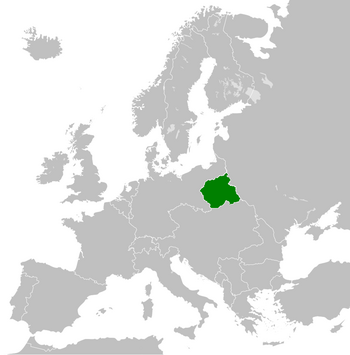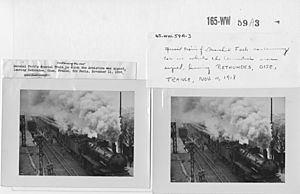Kingdom of Poland (1916-1918) facts for kids
Quick facts for kids
Kingdom of Poland
|
|||||||||
|---|---|---|---|---|---|---|---|---|---|
| 1917–1918 | |||||||||
 |
|||||||||
| Status | Client / puppet state of the German Empire |
||||||||
| Capital | Warsaw | ||||||||
| Common languages | |||||||||
| Government | Regency | ||||||||
| King | |||||||||
|
• 1917–1918
|
Vacant | ||||||||
| Head of State | |||||||||
|
• 14 Jan – 25 Aug 1917
|
Council of Statea | ||||||||
|
• 1917–1918
|
Regency Councila | ||||||||
| Prime Minister | |||||||||
|
• Nov 1917 – Feb 1918
|
Jan Kucharzewski | ||||||||
|
• 27 Feb – 4 Apr 1918
|
Antoni Ponikowski | ||||||||
|
• 4 Apr – 23 Oct 1918
|
Jan Kanty Steczkowski | ||||||||
|
• 23 Oct – 5 Nov 1918
|
Józef Świeżyński | ||||||||
|
• 4–11 Nov 1918
|
Władysław Wróblewski | ||||||||
| Historical era | World War I | ||||||||
|
• Established
|
14 January 1917 | ||||||||
| 3 March 1918 | |||||||||
|
• Armistice
|
11 November 1918 | ||||||||
| ISO 3166 code | PL | ||||||||
|
|||||||||
The Kingdom of Poland, also known informally as the Regency Kingdom of Poland was a proposed puppet state of the German Empire during World War I. The decision to propose the restoration of Poland after a century of partitions was taken up by the German policy makers in an attempt to further imperial widespread occupation in the territories. The plan was followed by the German propaganda pamphlet campaign delivered to the Poles in 1915, claiming that the German soldiers were arriving as liberators to free Poland from control by Russia.
A draft constitution was proposed in 1917. The German government used harsh threats to force Polish landowners living in the German-occupied Baltic states to relocate and sell their Baltic property to the Germans in exchange for the entry to Poland. The same efforts were made to remove Poles from Polish territories of the Prussian Partition.
Following the Armistice of 11 November 1918 signed by the Allies with imperial Germany, which ended World War I, the area became part of Second Polish Republic.
Early plans
Before the onset of war in 1914, for the purposes of securing Germany's eastern border against the Russian imperial army, it was decided on the annexation of a specific strip of land from Congress Poland, known later on as the Polish Border Strip. In order to avoid adding the Polish population there to the population of imperial Germany, it was proposed that the Poles would be moved to a proposed new Polish state further east, while the strip would be resettled with the Germans.
During the first year of the war, German and Austrian troops quickly conquered the Russian Vistula Land, the former Congress Poland, and in 1915, divided its administration between a German Governor General in Warsaw and an Austrian counterpart in Lublin.
Rather than focusing on mineral and industrial resources, the purpose of eastern expansion was to strengthen German agriculture, expand Junker holdings and acquire large settlement areas for the German farmers and settlers. In this way, the German leadership hoped both to please the Junker elites and, at the same time, ease the class conflicts in its rural areas. In addition, the confiscation of fertile territories was seen as one way of gaining war reparations (compensation payments) from Russia.
Images for kids
-
Occupation of the Kingdom of Poland during World War I: German Empire Occupied (from Russia) by Germany Austria-Hungary Occupied (from Russia) by Austria-Hungary Russian Empire
See also
 In Spanish: Regencia de Polonia para niños
In Spanish: Regencia de Polonia para niños










